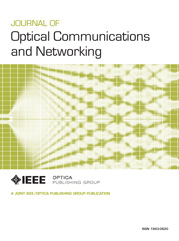Spatial Parallelism for Next-Generation High-Capacity Transport Networks
Call for Papers
Submissions Open: 1 March 2024
Submission Deadline: 3 June 2024
Parallelism has always been the key to increasing the capacity of optical networks, from single channel to WDM, C band to ultrawide band, and in the future through Spatial Division Multiplexing (SDM), where the spatial unit may be a core within a multi-core fiber (MCSDM), or a fiber within a bundle (FSDM). Designing such networks is not as simple as adding (or re-using pre-deployed) fibers in the field and then in the design tool. Key network elements, in particular, Wavelength Selective Switches (WSS), are reaching physical limits and no longer scale in terms of port count. Hence, there’s now a need for alternate solutions that do not require ultra-high port count WSS. It is unclear how such next generation networks will be implemented; however, novel large-throughput switching node architectures and enabling switching components, such as band, core or full fiber switches will be essential. Once such massive-capacity nodes and networks are built, efficient/scalable resource allocation methods (and the associated control plane) will be needed, while accounting for new sources of blocking introduced by the novel architectures and components.
The Journal of Optical Communications and Networking welcomes submissions to this special issue that highlight design and implementation of novel networking aspects of parallelism in fiber networks beyond C-band only networks that are now running out of capacity.
The scope of the special issue includes but is not limited to the following topics as they pertain to parallelism:
- Transport (submarine/core/regional/metro) networks (transmission-only papers are out of the scope)
- Large scale WSS including parallelism and integration aspects
- Design, implementation, integration, cost trade-offs of enabling components including multi-fiber amplifiers, multi-fiber WSS, multi-fiber transponders
- High-throughput switching node architecture and implementation
- Resource allocation strategies at the network level (including survivability aspects)
- Comparison of ultrawide band and fiber parallelism
- Implementation and operation issues: multi-core vs. parallel fibers
- Control plane standards, implementation and scalability
All submissions need to present original, previously unpublished work and will be subject to the normal standards and peer review processes of the journal. The standard JOCN Publication Charges will apply to overlength published articles. Please prepare manuscripts according to the usual standards for submission to the Journal of Optical Communications and Networking and submit through Optica Publishing Group's Prism submission system, specifying from the drop-down menu that the manuscript is for the Special Issue on Spatial Parallelism for Next-Generation High-Capacity Transport Networks.
Editors
Yvan Pointurier (Lead Editor), Huawei, France
Hiroshi Hasegawa, Nagoya University, Japan
Nihel Benzaoui, Google, USA
Jesse Simsarian, Nokia Bell Labs, USA

